包含的内容
1.从回调函数到STL。
2.队列 queue / deque的STL库。
2.优先队列priority_queue 的STL库,大小堆方法。
4.用栈和队列的STL解决问题。
4.1. 八皇后问题。
4.2.多括号匹配问题。
4.3.马踏棋盘问题。
从回调到STL
介绍一些回调,再列举STL的队列和栈。
C语言的回调
#include<stdio.h>
//回调方法一
void print(int n)
{
printf("调用 print() 输出%d\n",n);
}
void show1(int a,void (*ptr)())
{
(*ptr)(a);//也可以直接用 ptr(a); 因为函数指针可以直接使用。
}
void print2(int s)
{
printf("调用print2(),打印%d \n",s);
}
//回调方法二 用别名调用。
typedef void (*funtypename)(int n);//print(int n) 和 print2() 都满足该格式.
void show2(int a,funtypename f)
{
f=print;
f(a);
f=print2;
f(a);
}
int main()
{
show1(111,print);
printf("*************\n");
show2(22,print);
return 0;
}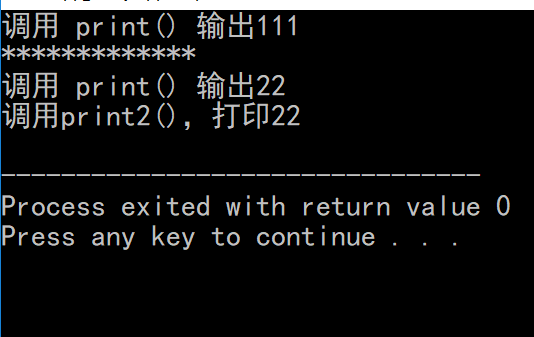
从C++的回调
#include<cstdio>
#include<queue>
#include<cstdlib>
#include<iostream>
#include<ctime>
using namespace std;
void print(int n)
{
printf("%d print() 被调用\n",n);
}
typedef void (*callback)(int n);//和print(int )一个格式
void show(int n,callback f)//用typedef调用
{
f=print;
f(n);
}
void show2(int n,void (*ptr)(int))//不用typedef调用
{
ptr(n);
}
int main()
{
callback p;//p是函数指针.等同于下句 p2
void (*p2)(int n);
show(1111,p);
show(1111,p2);
show2(2222,print);
return 0;
}
C++ 类仿函数
#include <iostream>
using namespace std;
typedef void(*Fun)(void);
inline void TextFun(void)
{
cout << "普通回调函数" << endl;
}
class TextFunor
{
public:
TextFunor()
{
cout<<"构造"<<endl;
}
~TextFunor()
{
cout<<"析构"<<endl;
}
void operator()(void) const
{
cout << "()重载函数" << endl;
}
};
void ForText(Fun pFun, TextFunor cFun)
{
pFun();
cFun();
}
int main()
{
TextFunor cFunor;
ForText(TextFun, cFunor);
return 0;
}STL的queue
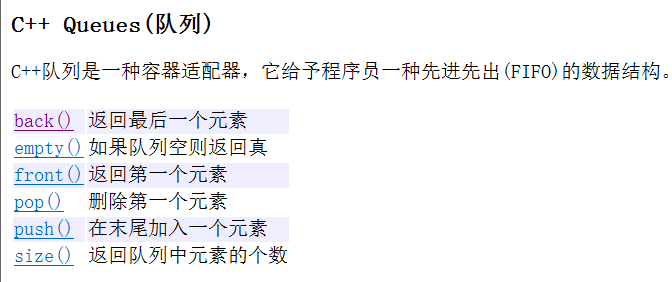
STL的priority_queue
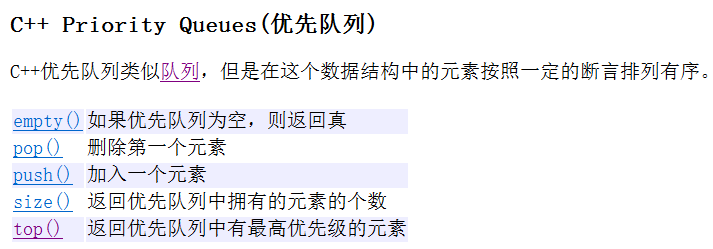
priority_queue 大小堆建立方法
priority_queue<tyoe,container,functional> 默认大顶堆,大的在队首。默认用operator<() 比较。
优先队列改为小堆的方法:
如int类的普通类型 用 priority_queue<int,vector<int>,greater<int>>自定义类型,重写operator<()【故意把小于写成大于不就成小堆了吗】或重写仿函数。
重写仿函数 priority_queue<int,vector<Node>,cmp>;cmp代表比较函数,(可以是内置的greater,less,也可以是防函数)写法如下。
#include <iostream>
#include<queue>
#include<vector>
#include<algorithm>
using namespace std;
typedef struct Node
{
int x;
int y;
bool operator()(Node a,Node b)//用于下文比较的仿函数。
{
return a.x>b.x;
}
void print()
{
cout<<"x="<<x<<" "<<"y="<<y<<endl;
}
}Node;
//在外面重载才能把
bool operator >(Node a,Node b)//重载大于,可用greater()函数。
{
return a.x>b.x;
}
bool operator <(Node a,Node b)//优先队列默认重载小于,有了小于可用于Node的入队。
{
return a.x<b.x;
}
struct cmp// 这是一个外部写的仿函数。
{
bool operator()(Node a,Node b)
{
return a.x>b.x;
}
};
int main()
{
priority_queue<Node,vector<Node>,greater<Node>> a;
//priority_queue<Node,vector<Node>,Node> a;
//priority_queue<Node,vector<Node>,cmp> a; 没有重载大于就自己写仿函数这样用。
//priority_queue<Node,vector<Node>,less<Node>> a;
Node b[3];
b[0].x=b[0].y=1;
b[1].x=b[1].y=2;
b[2].x=b[2].y=3;
a.push(b[0]);
a.push(b[1]);
a.push(b[2]);
Node c;
c=a.top();
c.print();
a.pop();
c=a.top();
c.print();
return 0;
}C++的stack
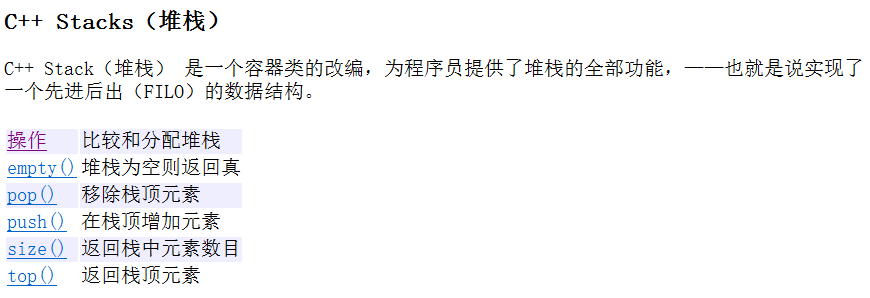
deque
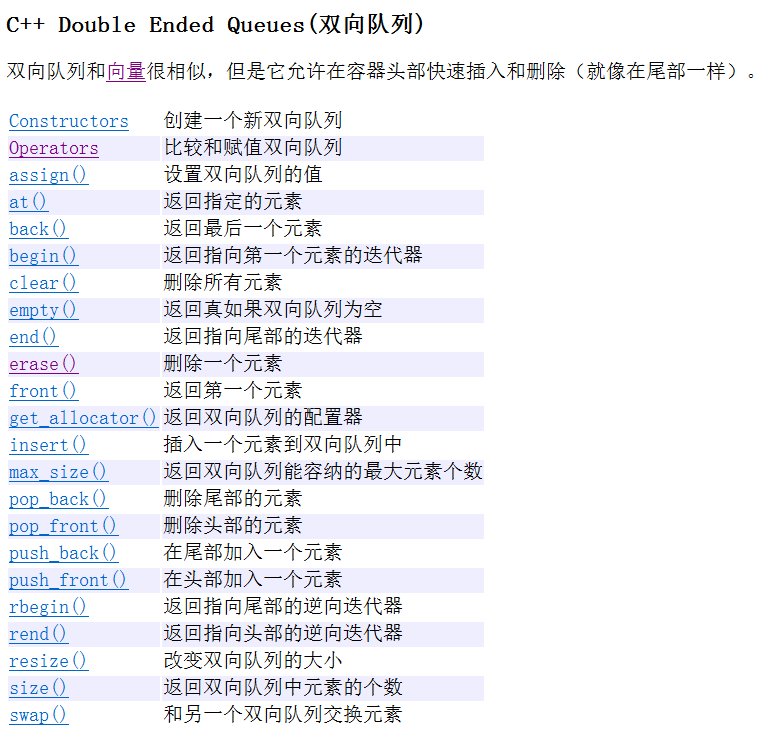
用堆栈的 STL 解决问题
多括号匹配

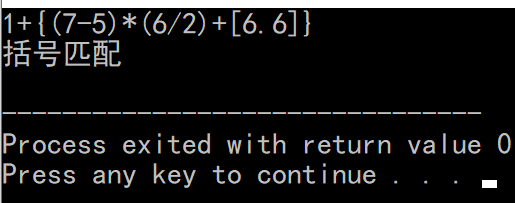
#include <iostream>
#include<stack>
#include<algorithm>
using namespace std;
// <{>} <>{}(<>)
int main()
{
stack<char> a;//() [] {} <>
char brackets[40];
loop:
scanf("%s",&brackets);
int i=0;
int b=true;
while(brackets[i]!='\0')
{
switch(brackets[i])
{
case '(':
{
a.push('(');
break;
}
case ')':
{
if(a.top()!='(')
{
b=false;
break;
}
else
a.pop();
break;
}
case '[':
{
a.push('[');
break;
}
case ']':
{
if(a.top()!='[')
{
b=false;
break;
}
else
a.pop();
break;
}
case '{':
{
a.push('{');
break;
}
case '}':
{
if(a.top()!='{')
{
b=false;
break;
}
else
a.pop();
break;
}
case '<':
{
a.push('<');
break;
}
case '>':
{
if(a.top()!='<')
{
b=false;
break;
}
else
a.pop();
break;
}
default:
{
break;
}
}
if(b==false)
{
break;
}
i++;
}
if(b)
{
printf("括号匹配\n");
}
else
{
printf("括号不匹配\n");
}
return 0;
}8皇后

#include <iostream>
using namespace std;
int kind=0;
const int N=8;
int arr[N+1],column[N+1],Left[2*N+1],Right[2*N+1];
void tryit(int i)
{
int j;
for(j=1;j<=8;j++)
{
if(!column[j]&&!Left[i-j+8]&&!Right[i+j])
{
arr[i]=j;column[j]=1;Left[i-j+8]=1;Right[i+j]=1;
if(i<8)
{
tryit(i+1);
}
else
{
kind++;
}
column[j]=Left[i-j+8]=Right[i+j]=0;
}
}
}
int main()
{
tryit(1);
printf("%d",kind);
return 0;
}马踏棋盘问题

#include <iostream>
#include<queue>
using namespace std;
int Next[8][2]={{-1,-2},{-2,-1},{-2,1},{-1,2},{1,2},{2,1},{2,-1},{1,-2}};
int map[8][8]={0};
typedef struct Node
{
int x;
int y;
int step;
}Node;
int main()
{
queue<Node> a;
Node Firstone={0,0,1};
a.push(Firstone);
map[0][0]=1;
Node Nextone;
Node Nowone;
int count=2;
while(!a.empty())
{
for(int i=0;i<8;i++)
{
Nextone.x=a.front().x+Next[i][0];
Nextone.y=a.front().y+Next[i][1];
if(Nextone.x<0||Nextone.y<0||Nextone.x>=8||Nextone.y>=8)
{
continue;
}
if(map[Nextone.x][Nextone.y]==0)
{
map[Nextone.x][Nextone.y]=count;
Nextone.step=a.back().step+1;
a.push(Nextone);
count++;
}
}
a.pop();
}
printf("广搜法,马踏棋盘的顺序:\n");
for(int i=0;i<8;i++)
{
for(int j=0;j<8;j++)
{
printf("%3d ",map[i][j]);
}
printf("\n");
}
return 0;
}





















 3000
3000

 被折叠的 条评论
为什么被折叠?
被折叠的 条评论
为什么被折叠?








